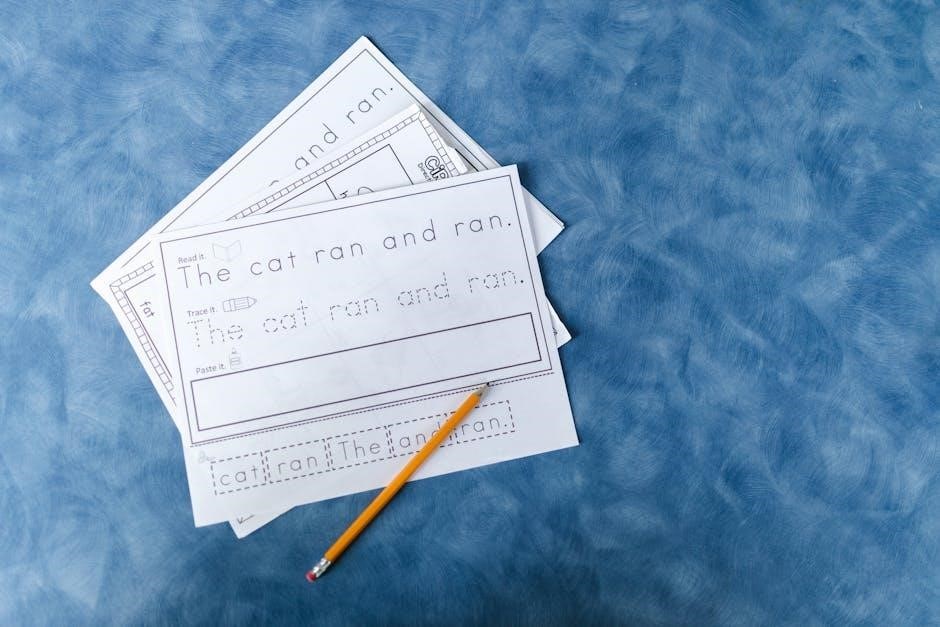unit rates worksheet pdf
- by corine

Unit rates are essential for comparing prices, speeds, and quantities, enabling efficient decision-making. Worksheets in PDF formats provide structured practice, enhancing mathematical proficiency and real-world application skills.

What Are Unit Rates?
Unit rates represent the ratio of two quantities where the second quantity (denominator) is 1. For example, earning $8.50 per hour or traveling 45.75 miles per hour. This concept simplifies comparisons, making it easier to understand rates like price per item, speed, or work done over time. Unit rates often use keywords such as “per” or division symbols (e.g., 6.55/hour) to indicate the relationship between quantities. They are fundamental in real-world applications, such as calculating costs, measuring efficiency, or determining distances. Worksheets, especially in PDF formats, provide structured practice for students to master unit rate calculations, ensuring a strong foundation in mathematical reasoning and problem-solving skills.
Importance of Unit Rates in Mathematics
Unit rates are a cornerstone of mathematical understanding, enabling students to grasp ratios, proportions, and real-world applications. They simplify complex comparisons, such as pricing or speed, making decision-making more efficient. Mastering unit rates enhances problem-solving skills, critical thinking, and logical reasoning. These concepts are vital in everyday scenarios, like calculating costs per item or determining travel time. Worksheets, particularly in PDF formats, provide structured practice, helping students build confidence and fluency. By focusing on unit rates, educators ensure students develop a strong foundation for advanced math topics, such as algebra and data analysis, while fostering practical, applicable skills for life.

How to Find Unit Rates
To find unit rates, divide the total quantity by the number of units, using division or the / symbol. This simplifies rates to a per-unit basis.
Understanding the Concept of Unit Rates
Unit rates represent the ratio of one quantity to another, simplified to a single unit. For example, earning $8.50 per hour or traveling 45.75 miles in one hour. These rates are essential for comparing prices, speeds, and quantities, enabling efficient decision-making. Understanding unit rates involves identifying the “per unit” relationship, often indicated by keywords like “per” or the division symbol “/”. This concept is fundamental in real-world applications, such as calculating costs, measuring efficiency, or determining the best value when shopping. Worksheets, especially in PDF formats, provide structured practice, helping students grasp this concept through various word problems and exercises.

Step-by-Step Process to Calculate Unit Rates
To calculate unit rates, start by identifying the two quantities involved, such as distance and time or cost and items. Next, set up a division problem where the numerator is the total quantity and the denominator is the number of units. For example, if 32.75 inches cost $6.55, divide $6.55 by 32.75 to find the cost per inch. Simplify the result to its lowest terms or round it if necessary. Always ensure the rate is expressed with one unit in the denominator. Practice with worksheets, such as those in PDF formats, to master this process and apply it to real-world scenarios like pricing, speed, and multi-step problems.
Examples of Unit Rate Calculations
Unit rate calculations involve determining the cost or rate per single unit. For instance, if 32.75 inches cost $6.55, the unit rate is calculated by dividing $6.55 by 32.75, resulting in the cost per inch. Similarly, if 14 books cost $56, the unit rate is $4 per book by dividing $56 by 14. Another example is earning $8.50 in 1 hour, which is already a unit rate. These calculations are often practiced in worksheets, such as PDF formats, to help students master the concept. Word problems involving pricing, speed, and multi-step scenarios are common, ensuring practical application of unit rates in real-world situations.
Benefits of Using Unit Rate Worksheets
Unit rate worksheets help students practice and understand unit rates through structured exercises. PDF formats offer convenience, while answer keys enable self-assessment and identification of learning gaps, fostering problem-solving skills.
Structured Practice for Students
Unit rate worksheets provide students with consistent and organized practice, helping them master the concept of unit rates. These worksheets typically include a variety of word problems, such as pricing, speed, and quantity comparisons, allowing students to apply their skills in different contexts. The structured format ensures that students can progressively build their understanding, starting from basic calculations to more complex scenarios. Many worksheets are available in PDF format, making them easily accessible and printable. With answer keys often included, students can self-assess their work and identify areas for improvement. This structured approach fosters a routine and systematic way of learning, enabling students to develop confidence and proficiency in calculating unit rates.
Identifying Learning Gaps
Unit rate worksheets are invaluable for identifying learning gaps in students’ understanding of mathematical concepts. By analyzing their performance on these worksheets, teachers can pinpoint areas where students struggle, such as incorrect division setup or misplacing decimals. The structured format of these worksheets allows for consistent tracking of progress, making it easier to spot patterns of errors. Additionally, answer keys provided with many worksheets enable students to self-assess and recognize their own learning gaps. This targeted feedback helps tailor instruction to address specific weaknesses, ensuring students receive the support they need to master unit rates. Regular use of these resources fosters a clearer understanding of where additional practice or review is necessary.
Building Problem-Solving Skills
Unit rate worksheets are a powerful tool for building problem-solving skills in mathematics. They provide students with a variety of real-world scenarios, such as calculating prices, speeds, and multi-step problems, which require critical thinking and analytical reasoning. By working through these exercises, students develop the ability to break down complex problems into manageable parts, identify key information, and apply mathematical concepts effectively. The structured nature of these worksheets, combined with answer keys and step-by-step solutions, helps students refine their strategies and build confidence in tackling diverse challenges. This systematic approach fosters a deeper understanding of unit rates and their practical applications, preparing students for more advanced mathematical problem-solving.

Convenience of PDF Formats
Unit rate worksheets in PDF format offer unparalleled convenience for both educators and students. They are easily printable, allowing for quick distribution in classrooms or at home. PDFs are also accessible on various devices, making them ideal for digital learning environments. The ability to download and store these worksheets ensures they are always available, reducing the need for constant internet access. Additionally, PDFs maintain consistent formatting across devices, ensuring clarity and readability. This convenience makes it easier for students to practice regularly and for teachers to integrate these resources into their lesson plans seamlessly. The portability and reliability of PDFs enhance the overall learning experience, providing a practical solution for mastering unit rates.
Types of Problems in Unit Rate Worksheets

Worksheets feature word problems involving pricing, speed, and distance, as well as comparing unit rates and solving multi-step problems, helping students apply mathematical concepts to real-life scenarios.
Word Problems Involving Pricing
Word problems involving pricing are a key component of unit rate worksheets, helping students understand the value per unit. For example, if 14 books cost $56, students calculate the cost per book by dividing the total cost by the number of items. These problems often involve real-world scenarios, such as determining the price per ounce of food or the cost per gallon of gas. By solving these, students learn to compare prices effectively and make informed purchasing decisions. Worksheets provide structured practice, ensuring students master the concept of unit rates in practical contexts. This skill is essential for everyday budgeting and financial literacy.
Calculating Speed and Distance
Calculating speed and distance is a fundamental application of unit rates, often featured in worksheets. Speed is typically expressed as distance divided by time, such as miles per hour (mph) or kilometers per hour (km/h). For example, if a car travels 366 miles in 8 hours, the unit rate is 45.75 mph. These problems help students understand how to find constant speeds and interpret real-world scenarios, like determining the time required to travel a certain distance. Worksheets provide numerous exercises, allowing students to practice converting between units and simplifying rates. This skill is crucial for understanding motion, transportation, and energy consumption in everyday life.
Comparing Unit Rates
Comparing unit rates involves determining which option offers the best value or efficiency. Worksheets often include problems where students analyze prices per item, speeds per unit time, or ratios of different quantities. For example, comparing the cost per ounce of two differently sized cans or the speed of two vehicles. These exercises help students identify which rate is more favorable or efficient. By practicing comparisons, learners develop critical thinking and decision-making skills. Such problems are common in real-world scenarios, such as shopping or transportation, making them highly relevant. Worksheets provide structured practice, ensuring students master this essential mathematical concept and its practical applications.
Multi-Step Unit Rate Problems
Multi-step unit rate problems require students to break down complex scenarios into manageable parts. These problems often involve calculating rates for multiple quantities or converting units before finding the final rate. For example, determining the cost per mile for a car trip involving different fuel prices or calculating the combined speed of two moving objects. Worksheets with multi-step problems help students develop problem-solving strategies and critical thinking. They encourage learners to approach challenges systematically, ensuring accuracy and understanding. Such exercises prepare students for real-world applications, where multi-step calculations are common. By practicing these problems, students build confidence and proficiency in handling intricate mathematical scenarios.
Features of Unit Rate Worksheets
Unit rate worksheets offer printable and digital formats, answer keys for self-assessment, and graded difficulty levels to cater to diverse learning needs and progress tracking.
Printable and Digital Formats
Unit rate worksheets are available in both printable and digital formats, offering flexibility for educators and students. Printable PDF versions allow easy access and can be used in classrooms or at home, while digital formats enable online practice and distance learning. This dual accessibility ensures that learning is uninterrupted, regardless of the environment. The convenience of these formats makes it easier for students to practice unit rate calculations, compare rates, and solve word problems. Additionally, printable worksheets can be distributed effortlessly, while digital versions reduce paper usage, catering to modern educational needs and preferences. This versatility enhances the overall learning experience, making unit rate practice more efficient and engaging for all learners.
Answer Keys for Self-Assessment
Unit rate worksheets often include answer keys, enabling students to assess their work independently. These keys provide immediate feedback, helping learners identify mistakes and understand correct solutions. By comparing their answers with the provided keys, students can track their progress and improve problem-solving skills. Answer keys also serve as valuable tools for educators to evaluate student performance and address learning gaps. The inclusion of answer keys in both printable and digital formats ensures convenience, whether students are working offline or online. This feature fosters a self-directed learning environment, empowering students to take charge of their math practice and reinforcement.
Graded Difficulty Levels
Unit rate worksheets are designed with graded difficulty levels to cater to diverse learning needs. Beginners can start with basic problems, such as calculating simple unit rates, while advanced learners can tackle complex scenarios involving multi-step calculations. The progression ensures that students build confidence and skills gradually. Worksheets for younger grades, like 5th and 6th, focus on foundational concepts, while those for high school students incorporate real-world applications and higher-order thinking. This tiered approach allows educators to tailor instruction, ensuring that all learners, regardless of their proficiency, can engage effectively. The inclusion of step-by-step solutions and examples further supports this structured learning path.
How to Use Unit Rate Worksheets Effectively
Use unit rate worksheets by starting with guided practice, then progressing to independent work. Incorporate real-world applications to enhance understanding and retention of unit rate concepts effectively.
Guided Practice
Guided practice is a foundational step in mastering unit rates, allowing students to work through problems with initial support. Teachers can use PDF worksheets to provide structured exercises, starting with simple unit rate calculations and gradually introducing more complex scenarios. Many worksheets include step-by-step examples and answer keys, enabling students to check their work and understand their mistakes. Interactive activities, such as filling in unit rate tables or solving word problems, help reinforce concepts. Guided practice also encourages collaboration, as students can work in pairs or small groups to discuss and solve problems. This approach ensures a smooth transition from teacher-led instruction to independent practice, building confidence and proficiency in calculating unit rates. Regular review of guided practice worksheets helps solidify understanding and prepares students for real-world applications of unit rates.
Independent Practice
Independent practice allows students to apply their understanding of unit rates without direct supervision. PDF worksheets are ideal for this, offering a variety of problems that range from simple to complex. Students can work at their own pace, solving problems like calculating unit prices for items, determining speeds, or comparing rates; Many worksheets include answer keys, enabling self-assessment and identification of areas needing improvement. Independent practice helps students develop problem-solving skills and builds confidence in their ability to apply unit rates to real-world scenarios. Regular independent practice reinforces learning and prepares students for more advanced mathematical concepts. It also encourages self-discipline and accountability in their academic journey.
Real-World Applications
Unit rates are fundamental in real-world scenarios, such as shopping, transportation, and sports. For instance, understanding unit prices helps consumers compare costs per ounce or pound to make budget-friendly decisions. In transportation, calculating miles per gallon or kilometers per liter enables efficient fuel management. Athletes and coaches use unit rates to measure speed, like miles per hour or minutes per mile, to track performance. Worksheets with word problems involving pricing, speed, and quantity comparisons provide practical exercises that mirror real-life situations. By mastering unit rates, students gain essential skills for making informed decisions in everyday life, from grocery shopping to understanding travel efficiency.

Common Mistakes to Avoid
Common errors include incorrect division setup, misplacing decimals, and not simplifying fractions. These mistakes can lead to inaccurate unit rates, so attention to detail is crucial.

Incorrect Division Setup
One common mistake is setting up the division incorrectly when calculating unit rates. For instance, if a problem states “32.75 in 5 hours,” some students might divide 5 by 32.75 instead of 32.75 by 5. This error occurs when the numerator and denominator are reversed, leading to an incorrect unit rate. It is essential to understand that unit rates represent the cost or quantity per single unit, so the division must reflect this relationship. Missetting the division can result in misleading comparisons, especially in real-world scenarios like pricing or speed calculations. To avoid this, always ensure the unit being measured (e.g., hours, items) is in the denominator. This simple step helps maintain accuracy and ensures the unit rate is meaningful. Practicing with worksheets can help students master this concept and reduce errors over time.
Misplacing Decimals
Misplacing decimals is a frequent error when calculating unit rates, leading to incorrect results. For example, if a student finds that 32.75 units correspond to 5 hours, they might incorrectly place the decimal, resulting in 6.55 instead of 6.55. This mistake often occurs due to rushed calculations or a lack of attention to detail. Properly placing decimals ensures accuracy, especially in real-world applications like pricing or speed calculations. Worksheets with answer keys can help students identify and correct such errors. Practicing with structured problems in PDF formats allows learners to develop precision and confidence in their calculations, reducing the likelihood of decimal misplacement over time.
Not Simplifying Fractions

Not simplifying fractions is a common mistake when calculating unit rates, leading to unnecessary complexity. For instance, if a student determines that 32.75 units correspond to 5 hours, they might leave the answer as 32.75/5 instead of simplifying it to 6.55 per hour; Similarly, when calculating the cost per book for 14 books costing $56, failing to simplify 56/14 to $4 per book can cause confusion; Simplifying fractions ensures clarity and accuracy, especially in comparisons. Worksheets with answer keys can help students identify such errors and improve their fraction skills. Regular practice with PDF resources enhances understanding and reduces mistakes over time.
Mastering unit rates empowers students to solve real-world problems efficiently. Worksheets and consistent practice foster confidence and proficiency in mathematical reasoning and application.
Unit rates represent the ratio of one quantity to another, simplifying comparisons and decision-making. Worksheets in PDF format offer structured practice, helping students grasp the concept through word problems, speed calculations, and pricing scenarios. These resources provide clear examples and step-by-step solutions, catering to various grade levels. By mastering unit rates, students enhance their problem-solving skills and apply mathematical concepts to real-world situations. Regular practice with worksheets ensures a strong foundation in ratios, proportions, and data analysis, making them invaluable tools for both classroom and independent learning environments.
Encouragement for Further Practice

Consistent practice with unit rate worksheets is key to mastering this essential math skill. Encourage students to explore various resources, such as PDF worksheets, to reinforce their understanding. These tools offer structured exercises, word problems, and real-world applications, making learning engaging and practical. By regularly practicing, students can build confidence and improve their ability to solve complex problems. Parents and educators should motivate learners to apply unit rates in everyday scenarios, such as comparing prices or calculating speeds, to deepen their comprehension. With dedication and practice, students will become proficient in using unit rates to make informed decisions and solve mathematical challenges effectively.
Related posts:
Get free unit rates worksheets PDF for math practice. Printable sheets perfect for students and teachers. Download now!
Posted in PDF